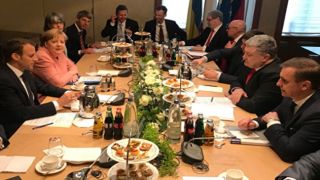Eight years have passed since the South Caucasus was hit by a horrific tragedy called “Five-Day War” that started with Mikheil Saakashvili’s attack on the territory of South Ossetia, killings of Russian peacekeepers and the peaceful population of Tskhinval and the adjacent villages. The bleeding wounds of that war have not healed yet and it is extremely important to find out the real reasons of that tragedy and names of those guilty in that horrific crime.
The conflict in South Ossetia is almost one-century-old. Yet Mensheviks ruling the first Republic of Georgia after the collapse of the Russian Empire in 1920 had tried to restore “Constitutional order” in South Ossetia. Then, more than 5,000 people were killed in its territory. In the Soviet period, national issues were settled quite easily – once and forever – though even then there were regular public disorders in Abkhazia. To suppress them, the known 8th Regiment of the Tbilisi-based internal troops was sent.
With the collapse of the Soviet Union, ethnic conflicts in its territory have flared up again. The national minorities that were somehow protected under the Soviet power, proved extremely vulnerable, amid xenophobic statements by Zviad Gamsakhurdia, the then leader of Georgia.
Political analyst Sergey Markedonov has published a citation from Zviad Gamsakhurdia’s speech at a rally in the village of Eredvi: “I will be in Tskhinvali soon with 10,000 of my falcons and we will see how the public in Tskhinvali will welcome them. We will twist their necks, the more so as it will not be hard to restrain such weak opponents as Ossetians are. Half of Georgia will be with us. Then we will see who will win and who will shed more blood.”
Here is another citation by Gamsakhurdia: “Ossetian people [are] trash that has to be swept out through a tunnel. We will go through Ossetia and let Ossetians bend and become Georgians, or if they love Russians so much, let them leave Georgia for Russia.”
That man did not even conceal that he considered the RSA under Apartheid as the best option for Georgia. Yet, he did not declare that officially. All that made inevitable the reaction by the autonomies that were liquidated by the new authorities. Abkhazia, Ajaria, and South Ossetia de-facto went out of Tbilisi’s control. In Ajaria that process was peaceful thanks to Aslan Abashidze, unlike Abkhazia and South Ossetia where intensive military actions broke out and the unrecognized republics have emerged.
On June 24, 1992, an agreement was signed in Dagomys to determine the principles of the conflict settlement and set up a Joint Control Commission to settle it. The commission involved representatives of Georgia, Russia, North and South Ossetia. On July 14, a ceasefire was announced and joint peacekeeping forces – Georgian, Russian and Ossetian battalions - were deployed to divide the conflicting sides.
Such a situation emerged due to the imperfect international law recognizing at once two diametrically opposite principles of territorial integrity and the people’s right to self-determination. All this leads to a situation when settlement of conflicts depends not on the idea of justice and human rights, but on the distribution of political forces at a particular moment. This is how East Pakistan gained independence and turned into Bangladesh – a country with a population larger than populations of several big European countries taken together - Eritrea, South Sudan and others. The freshest and the most disputable example is Kosovo that was cut from Serbia without any referendums and polls. NATO’s bombardments of Serbia proved the best arguments for “the stubborn.”
The Russian Federation found itself in a very complicate situation, as the official recognition of Georgia’s territorial integrity did not waive the responsibility for the fate of the population in Abkhazia and South Ossetia.
After another Orange Revolution, representatives of the United National Movement led by Mikheil Saakashvili started fomenting tensions in the country. In the village of Ergneti, there was a big fair where people were trading in Russian and Georgian goods. Trade was bringing the Georgians and Ossetians closer and defusing tensions. Many earned for life then, as the economic situation in Georgia was heavy. However, the fair was closed and liquidated by the new authorities, which deprived many families of their living.
In August 2004, the United National Movement tried to take control over the strategic heights around Tskhinval by force. Dozens were killed in bloody fights then. Saakashvili failed to implement his task, but he did not abandon his plans.
The Georgian army started actively training to meet NATO standards. Large lots of arms, combat vehicles and munitions were supplied. The military budget of the country grew more than 30-fold in 2003-2007 – from 30 million to 940 million dollars. It was an absolute world record by the military expenditures in the ratio to GDP. All this happened in a country where half of the population left abroad as migrant workers and the rest lived at the poverty level.
About two dozens of countries supplied arms to Georgia, but Ukraine had a special role in it, as Saakashvili’s fellow sponsor Viktor Yushchenko was the president there. To be fair, “revolutionaries-reformists” promoting bright ideas of democracy and justice never forget about their personal benefits. The military equipment and munitions supplied to Georgia were outdated and sometimes even subject to disposition, but the prices were very high. It is not hard to guess where the difference in price went to.
Defense Minister of Georgia Irakli Okruashvili said he would resign if he failed to meet the year 2007 in Tskhinval. He hoped G8 will manage to force Russia to capitulate. Immediately after disputing with Saakashvili, he said there was an operation called “Tiger Throw.” The former minister said the attack on South Ossetia in August of 2008 was not spontaneous.
The Russian-Georgian relations become strain in autumn of 2006. Russian military and citizens of Georgia were arrested in Tbilisi over espionage. Illegal Georgian migrants were deported from Russia. Georgia filed claims to the international court against Russia. Illegal penetration into a country and illegal stay in its territory is considered a violation of the law in any country. However, it should be noted that about 400-800 people were deported, though there were an estimated 1-1.5 million illegal Georgian migrants in Russia then.
Whether accidentally or not, but after the visit by Secretary of State Condoleezza Rice, on the day the Beijing Olympic Games opened, a military operation called “Clear Field” was launched.
To be continued
By Giorgi Goginashvili for EADaily


